Olympiad Notes: Data Handling | Maths Olympiad Class 6 PDF Download
| Table of contents |

|
| Introduction |

|
| Recording Data |

|
| Organization of Data |

|
| Pictograph |

|
| Bar Graph |

|
Introduction
Data refers to information or facts that are collected and used for various purposes. Handling data involves managing, organizing, analyzing, and making sense of this information. 
Recording Data
- Recording of data depends upon the requirement of the data.
- Everybody has different ways to record data.
- For example, if we want to see which movies people like, we need to collect data from surveys where people share their movie preferences.
Organization of Data
- Raw data is difficult to read, so we have to organize it in such a way so that we can use it in need.
- Data can be organized in a tabular form.
- Data is represented in a tabular form using frequency distribution and the tally marks.
(i) Frequency tells the number of times the particular observation happened.
(ii) Tally marks are used to show the frequency of the data. They are represented as:-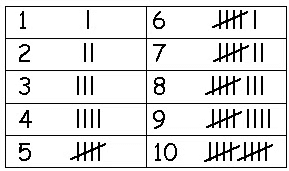
Example: There are 30 students in a class. They have to choose one sport each for the sports period.
5 took badminton,
10 took cricket,
4 took football,
1 took hockey,
3 took tennis, and
7 went for volleyball.
Represent this data in the frequency distribution table.
Sol: To make a frequency distribution table-
- Make a table with three columns.
- Write the name of sports in the first column.
- Write the respective frequencies in front of each sport.
- Mark the tally marks according to the frequency given.

Pictograph
- If we represent the data with the pictures of objects instead of numbers then it is called Pictograph.
- Pictures make it easy to understand the data and answer the questions related to it by just seeing it.
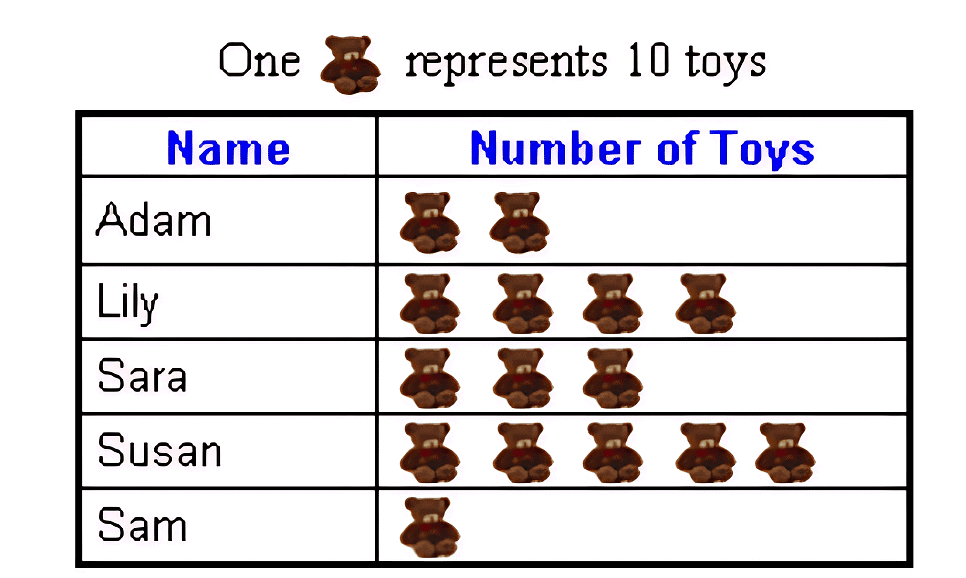
We can easily answer the questions like who has a maximum number of toys, who has the least number of toys etc.
Interpretation of a Pictograph
- In the pictograph, we have to understand it and get the information from the pictures given.
- If we have to represent more number of items then we can use the key which represents more numbers with one picture.
Example: The number of cars parked in a parking lot every day is given in the pictograph.

(i) Find the day when the highest number of cars are parked and how many?
(ii) When the least number of cars did park?
Sol: In the above pictograph one car represent 5 cars.
(i) As there is the maximum number of cars is shown on Tuesday so the highest number of cars was parked on Tuesday.

Hence, 40 cars were parked on Tuesday in the parking lot.
(ii) Least number of cars were parked on Monday as there are only 4 pictures of cars are shown on that day.
Drawing a Pictograph
- Drawing pictographs is enjoyable, but complex pictures might be challenging to recreate.
- Using simpler symbols can make pictograph creation easier.
- It's important to provide a clear key for the symbols used to ensure easy understanding by everyone.
Example: The following table shows the choice of the fruits of the 35 students of class 3. Represent the data in a pictograph.
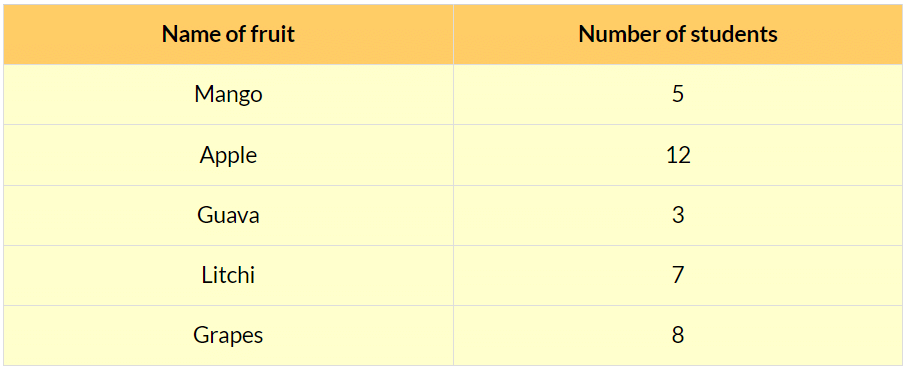
Sol:
Bar Graph
- Making pictographs can be quite time-consuming, requiring careful drawing and arrangement of symbols.
- There's a simpler alternative for displaying data.
- Instead of drawing pictures, we can use bars of uniform width, ensuring they're evenly spaced apart.
- The length of each bar represents how frequently something occurs or appears in the data.
- This type of graphical representation is commonly known as a Bar Graph or Bar Diagram.
Interpretation of a Bar Graph
Example: The following graph tells the favourite colours in a class of 30 students.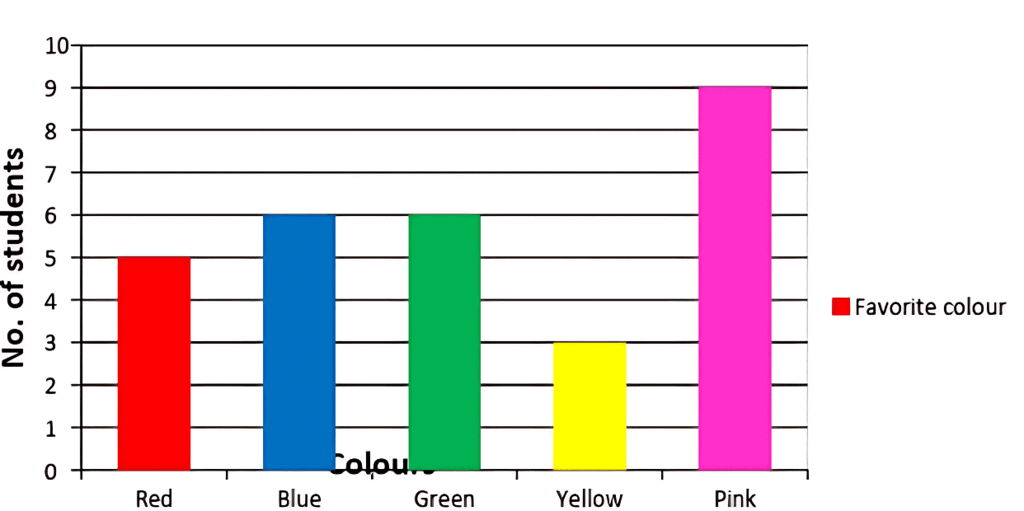
(i) Which colour is liked by the maximum number of students?
(ii) Which colour is liked by the same number of students?
Sol: (i) The graph shows that the pink colour is liked by 9 students so it is the favourite colour of the maximum number of students.
(ii) Blue and green colour bars are equal in length and both are liked by 6 students.
Drawing a Bar Graph
- Drawing a bar graph is an interesting task, but we must choose an appropriate scale to draw the bar graph.
- It depends upon our own choice that what we are taking for the scale.
Example: The daily sale of mobile phones in Vicky production is given below. Draw the bar graph to represent the data.
Sol: Steps to make a bar graph-
- Draw two lines, one horizontal and one vertical in L shape.
- Mark days on the horizontal line and no. of phones on the vertical line.
- Take a suitable scale for the number of phones and mark on the vertical line. Let 1 unit = 10 phones.
- Use the bars of equal width and draw them with the frequency given at the same distance.
- The height of the bars tells the sale of the mobile phones in Vicky production.
 This same bar graph can be made by interchanging the positions of the days and the number of phones.
This same bar graph can be made by interchanging the positions of the days and the number of phones.
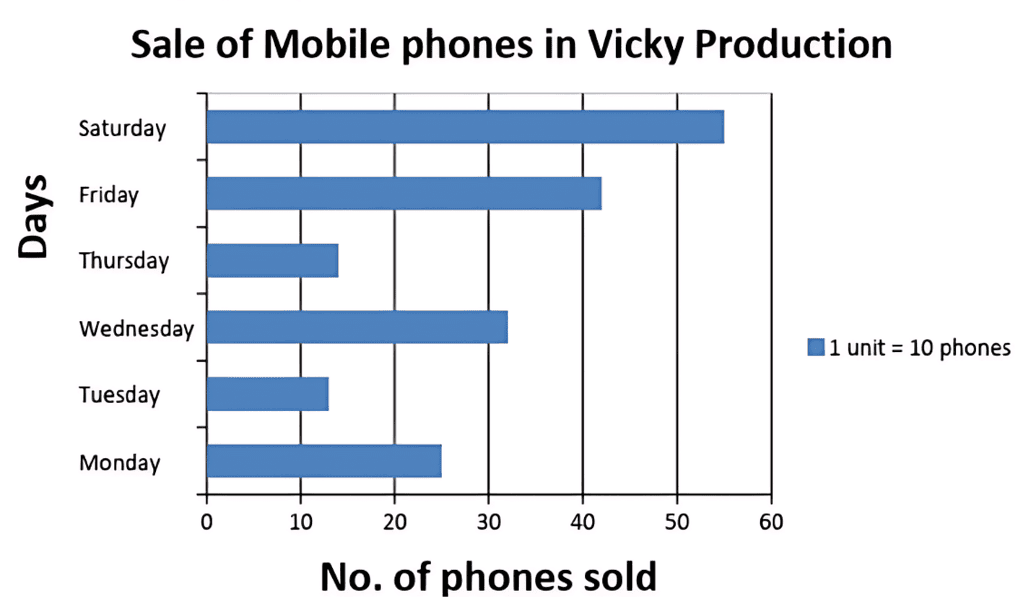
Practice Question: The given data shows the number of goals scored by a player in 24 different football matches. Study the data carefully and answer the following question.
2, 3, 2, 1, 0, 4, 3, 1, 2, 0, 3, 2, 1, 3, 0, 2, 5, 2, 4, 3,1, 2, 1, 3
How many times the player scored at least 2 goals?
Sol: Here, we've to calculate the number of times the player has scored at least 2 goals.
Al least 2 implies greater than or equal to 2.
So, total no. of times the player has scored at least 2 goals is 16 times(2, 3, 2, 4, 3, 2, 3, 2, 3, 2, 5, 2, 4, 3, 2, 3).
|
31 videos|126 docs|59 tests
|
FAQs on Olympiad Notes: Data Handling - Maths Olympiad Class 6
| 1. What is the importance of recording data in data handling? |  |
| 2. How can data be organized effectively in data handling? |  |
| 3. What is a pictograph and how is it used in data handling? |  |
| 4. How is a bar graph different from a pictograph in data handling? |  |
| 5. Why is it important to use both pictographs and bar graphs in data handling? |  |




















